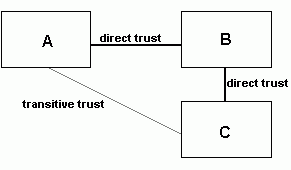Transitive Trust Relationships
A transitive trust relationship comes about as a result of a direct trust relationship. In this relationship, cells in a direct trust relationship trust (with some constraints) each other's authentication service to authenticate principals not only from their respective cells but also from the cells with which they have direct trust relationships. A transitive trust relationship can involve three or more cells. A transitive trust relationship is illustrated in the following figure.
Transitive Trust Relationships

In this figure, cell A trusts peer cell B (the cell with which it has a direct trust relationship) to authenticate the principals in cell B and to guarantee the authentication of the principals in cell B/C (the cell with which it has a transitive trust relationship).
Because cell A trusts cell B's authentication service, it allows authenticated access to all principals whose authentication is guaranteed by cell B's authentication service. These authenticated principals include principals from cell B and principals from cell B/C.